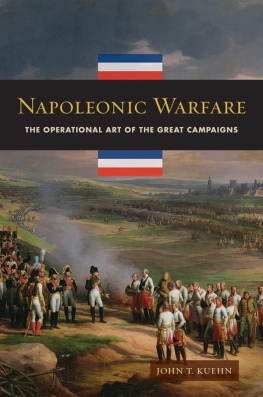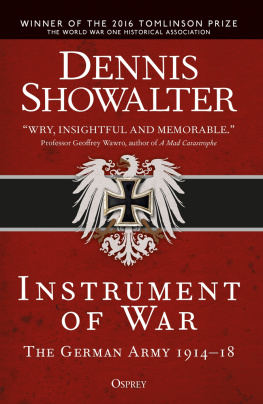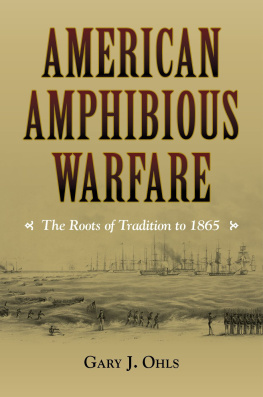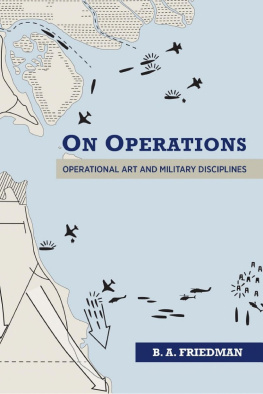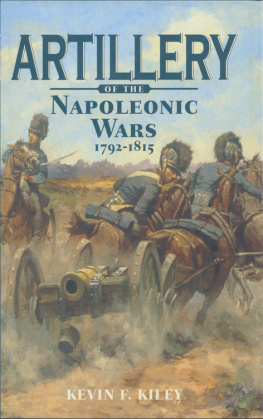NAPOLEONIC WARFARE
NAPOLEONIC WARFARE
THE OPERATIONAL ART OF THE GREAT CAMPAIGNS
JOHN T. KUEHN
Copyright 2015 by John T. Kuehn
All rights reserved. No part of this publication may be reproduced, stored in a retrieval system, or transmitted, in any form or by any means, electronic, mechanical, photocopying, recording, or otherwise, except for the inclusion of brief quotations in a review, without prior permission in writing from the publisher.
Library of Congress Cataloging-in-Publication Data
Kuehn, John T.
Napoleonic warfare : the operational art of the great campaigns /
John T. Kuehn.
pages cm
Includes bibliographical references and index.
ISBN 978-1-4408-3307-6 (alk. paper) ISBN 978-1-4408-3308-3 (EISBN)
1.Napoleonic Wars, 18001815Campaigns.2.Operational art (Military science)History19th century.3.First Coalition, War of the, 17921797Campaigns.4.Second Coalition, War of the, 17981801Campaigns.I.Title.
DC226.4.K84 2015
940.2'74dc232015005479
ISBN: 978-1-4408-3307-6
EISBN: 978-1-4408-3308-3
191817161512345
This book is also available on the World Wide Web as an eBook.
Visit www.abc-clio.com for details.
Praeger
An Imprint of ABC-CLIO, LLC
ABC-CLIO, LLC
130 Cremona Drive, P.O. Box 1911
Santa Barbara, California 93116-1911
This book is printed on acid-free paper 
Manufactured in the United States of America
CONTENTS
MAPS
FIGURES
WAR IS THREE DIMENSIONAL
This book has a very simple premise: European warfare from 1793 to 1815 lends itself particularly well to an operational-level analysis. Modern war is three-dimensional, divided by modern doctrine into three levels of war. At the lowest end of the spectrum is the tactical level, the level of the engagement or the battle. Combat. At the high end are strategy and grand strategy, how the military forces are used with other forms of national power to achieve political ends. In between these two is the operational level, the level of the campaign, or a series of engagements, fought to achieve a particular military purpose, but which might or might not lead to a situation resulting in final military victory or a suspension of hostilities.
It has only been in modern times that the term operational level of war has come to encompass its own distinct niche in discussions of military art and science. Most military historians treated the topic similarly (and some still do). War, it seemed, was naturally two-dimensionaltactics and strategy. War is certainly not two-dimensional, nor is it linear. Of the three levels of warstrategic, operational, and tacticalthe one that is least understood and written about resides in that always uncomfortable middle ground, the operational level.
The size, scope, and complexity of operations during the Napoleonic era increased exponentially along with the profound political events shaking and shaping the societies of Europe. Huge armies, then army groups, and finally entire armed societies went at it in a series of complex and interlinking campaigns on a scale not seen in Europe since Roman times. Carl von Clausewitz, arguably among the first of the modern operational analysts, famously wrote: but in 1793, a force appeared that beggared all imagination. Suddenly war again became the business of the peoplea people of thirty millions, all of whom considered themselves to be citizens. He wrote about France and the force of armed nationalism that the French Revolution unleashed upon Europe. Armed nationalism is not a thing of the past and neither is revolution. In the past we find the stuff of the present, patterns that, if examined, can help us navigate the troubled waters of our own day.
Clausewitzs judgment captures one of more profound truths about the military revolution that occurred during the wars that took place after the French Revolution began.
Given the complexity of warfare during the period 17921815, it lends itself naturally to an operational-level investigation. Accordingly, the character of this book will reflect two operational frameworks of analysis. The first is that developed by the first generation of Soviet military thinkers between 1918 and 1941. The Germans had pioneered the usage and vocabulary for an operational level of war. However, as with most new concepts, it was not the discoverers who established the mature framework for a coherent approach to an operational approach to practicing war at this level. The Soviets reaped where the Germans had sown.
Most of the sources used for this book are secondary and may appear dated with respect to their interpretations. They are used to get the basic facts, which at the operational level of war are largely establishedfor example, it is clear that the Napoleon was victorious in the Austerlitz campaign while he was not in the 1812 Russian campaign. Some of the conclusions presented here are not startlingly new as far as the facts are concerned; research using new or little-used primary resources is necessary for a scholar to make such a claim. This book instead proposes a new line of analysis for the Napoleonic Wars along principally operational lines. I also realize that using 20th-century military theory to explain 18th and 19th century events has some inherent analytical flaws, superimposing concepts that were not part of the framework that Napoleonic leaders and generals worked from in making military decisions. However, it can be argued (and will be later in this book) that at the very least Napoleon and his talented subordinate Baron Antoine de Jomini understood the basic principles of operational war and, at least in Jominis case, had codified the first cut. The Prusso-Germans, too, seemed to understand the profound implications of the emergence of a new level of war, and Clausewitz even referred to them as operative elements in On War in referencing his book that deals with military strategy at the campaign level.
The book will focus primarily at the campaign level and Napoleonic tactics will not be explored in detail and only come up in discussion as they directly relate to the operational levelsuch as the use of cannon by brigades and regiments of the period to give them more firepower and thus operational durability. For the reader who wants more on tactical developments of the period, David Chandlers fine discussion entitled Napoleons Art of War in The Campaigns of Napoleon has some excellent discussions of tactical evolutions during the period, especially on the issues of skirmishing and various tactical formations such as the column, line, and mixed order. For even more detail, Brent Nosworthys With Musket, Cannon and Sword synthesizes all the elements of the battlefield to give one an accurate view inside the black box of the tactics as they were actually executed on the battlefields of the period.
In summary, this book aims for something of an impressionistic result that suggests the operational-level approach adopted here illustrates effectively the more esoteric concept of operational arthow military genius, as best defined by Clausewitz, operated in space and time in the uncertain environment at the operational level during the era of a veritable God of War.
I owe a debt of gratitude to David Chandler for his wonderful

